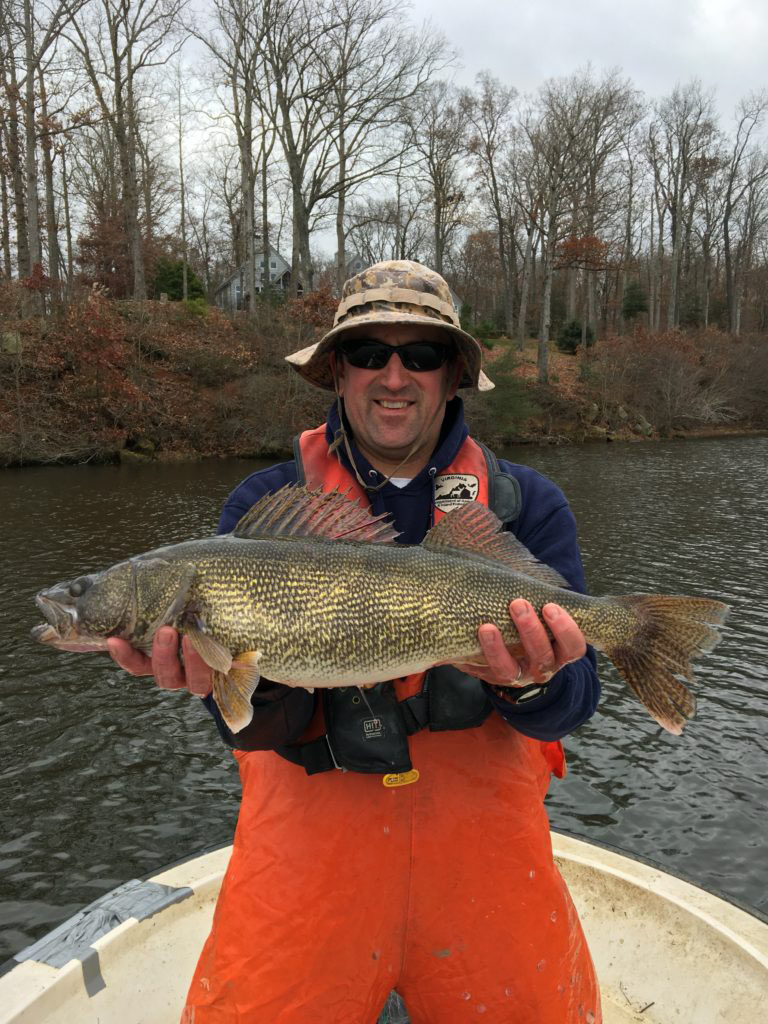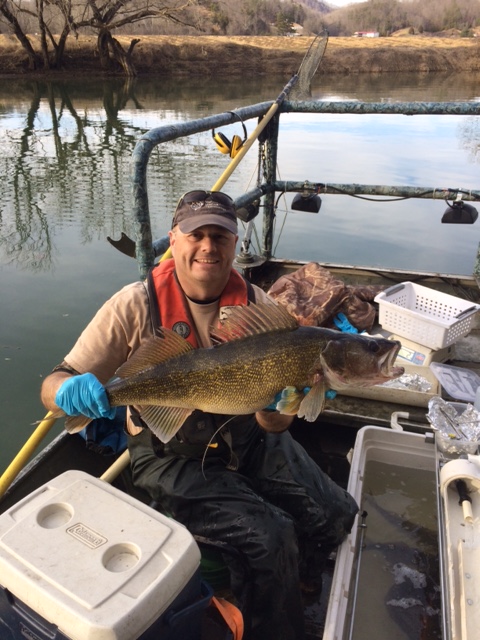If you’re looking to fish for something new that is exciting, simple, and low-cost to catch this spring and summer, look no further than the cool waters of Southwest Virginia, where walleye abound. Native to the Clinch and Holston Rivers in Virginia, and the largest member of the perch family, the Virginia walleye are known to grow from four to ten pounds. Virginia hosts some of the largest walleye available anywhere in the country.
 The Virginia Department of Game & Inland Fisheries (DGIF) aquatics staff uses state-of-the-art techniques to collect, grow, and stock walleye in various waters across the state. Walleye fishing success is dominant in waters located in the southwest. The Upper New River, South Holston Lake, the Clinch River, Flannagan Reservoir, and Hungry Mother Lake are plentiful in walleye this year. Each of these fishing destinations are described below.
The Virginia Department of Game & Inland Fisheries (DGIF) aquatics staff uses state-of-the-art techniques to collect, grow, and stock walleye in various waters across the state. Walleye fishing success is dominant in waters located in the southwest. The Upper New River, South Holston Lake, the Clinch River, Flannagan Reservoir, and Hungry Mother Lake are plentiful in walleye this year. Each of these fishing destinations are described below.
Every year, DGIF collects adult walleye to use as “broodstock.” Broodstock are fish that are captured by DGIF aquatics staff, brought into a DGIF hatchery, spawned, and then returned to the water. The offspring of these broodstock support DGIF’s walleye stocking program. The purpose of stocking is to establish or maintain walleye fisheries that typically aren’t successful in naturally reproducing in Virginia. Walleye fingerlings (small, young fish) are released into waterbodies throughout the state so they can mature into catchable fish for anglers. After these walleye fingerlings are stocked, they will grow for three years before reaching legal size, which varies depending on body of water.
Walleyes often congregate in pools just below significant ledges and shoals during daylight hours, then move into shallow water at dusk. In addition, an ideal destination to find walleye is where a creek enters the river. Crankbaits, jigs, and live minnows work well for catching them during the late winter and spring season. Trolling with nightcrawler harnesses (spinner rigs) is the preferred method in reservoirs during the summer months. Overall, live baits such as minnows, shad or nightcrawlers are favorable options for walleye. Late winter and early spring is the best time to catch these fish.
Walleye fishing on the Upper New River from Buck Dam downstream to Allisonia will improve in 2018 as a result of annual stocking since 2014. In addition, the 2015 and 2017 stockings will provide increased numbers of walleye for anglers from fries Dam to Byllesby Reservoir in 2018 and into the future. Ivanhoe, Foster Falls, and Allisonia are primary destinations to fish walleye this year.
When you fish for walleye on the Upper New River, follow these size and creel limits:
From Buck Dam downstream to Claytor Lake Dam: From February 1 through May 31: All walleye 19 to 28 inches caught must be released unharmed. Anglers may keep 2 walleye per day less than 19 inches or over 28 inches.
- From June 1 through January 31: A 20-inch minimum length limit with a five per day creel limit is in effect. This regulation allows anglers to harvest a few smaller male walleyes (typically less than 19 inches) or a trophy female walleye (typically greater than 28 inches) while protecting the best spawning-size walleyes during the spring months.
From Fries Dam downstream to Buck Dam: A 20-inch minimum length limit for walleye, with a 5 per day creel limit is in effect year-round. This regulation is designed to protect the walleye population stocked in Byllesby Reservoir that runs upstream to Fries Dam.
South Holston is expected to provide excellent walleye fishing this year. Anglers can expect satisfactory catches during the spring spawning run on the South Fork Holston River. Anglers generally congregate near the community of Alvarado from February through April to catch walleyes on the spring spawning run. During May and June, anglers can find walleyes feeding along the shorelines of the lake. The post spawn top water bite in the lower lake will yield the best walleye fishing Virginia offers. When walleyes move deeper during the summer months, successful anglers troll crawler harnesses on lead core line or use jigging spoons to reach the depths. Fall and winter fishing require jigging spoons, or jigs and live minnows.
 Flannagan Reservoir is also expected to provide beneficial opportunities for walleye and saugeye fishing this year. Although the combined catch rate for these two species in late 2017 was down slightly from the previous year, there should be a good number of legally harvestable fish during the spring and summer of 2018. Walleye in the Flannagan Reservoir typically reach the 18-inch minimum length limit between their second and third year.
Flannagan Reservoir is also expected to provide beneficial opportunities for walleye and saugeye fishing this year. Although the combined catch rate for these two species in late 2017 was down slightly from the previous year, there should be a good number of legally harvestable fish during the spring and summer of 2018. Walleye in the Flannagan Reservoir typically reach the 18-inch minimum length limit between their second and third year.
The Virginia Department of Game and Inland Fisheries will be conducting a third year of walleye tagging on Flannagan Reservoir in 2018. This will be part of an ongoing study aimed at evaluating the level of angler exploitation directed toward this fishery. Anglers catching tagged fish are encouraged to report them to DGIF to claim a $20 reward for each tag!
Walleye are native to the Clinch River and are available in somewhat low densities throughout most of the river. Walleye collected in the 2017 sample ranged from 14 to 22 inches. Currently, there is a favorable number of harvestable walleye within the areas of Clinchport, Fort Blackmore, and Dungannon, which generally hold higher concentrations.
This 108-acre lake provides anglers with a great opportunity to catch walleye in a small lake setting. Located in Hungry Mother State Park, the lake makes a great destination for family trips. The walleye population here is stable or slightly increasing. There are good numbers of fish up to 20 inches and a favorable number of larger fish. Walleye’s up to 28 inches in length have been caught in recent years. April, May, and June are the primary months, and night fishing is generally more productive. Most anglers use artificial lures, but live shad, minnows, and night crawlers are also effective in this lake.
Buy your license now to provide DGIF Fisheries with the resources that will ensure the walleye fishing thrives into coming generations.

